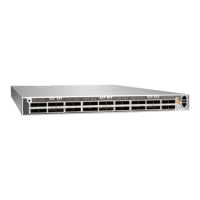5—
USB port (USB 2.0 standard)
You manage the PTX10001-36MR by using the Junos OS Evolved CLI, which is accessible through the
console and out-of-band management ports on the front panel. In addion, the front panel has system
status LEDs that alert you to minor or major alarms or other issues with the router, external clock
synchronizaon ports, and a USB port to support soware installaon and recovery.
The network ports on the PTX10001-36MR consist of 24 QSFP56-DD ports that support data rates of
10-Gbps, 25-Gbps, 40-Gbps, 100-Gbps, and 400-Gbps and 12 QSFP28 ports that support data rates of
10-Gbps, 25-Gbps, 40-Gbps, and 100-Gbps.
Cooling and Power
The cooling system in a PTX10001-36MR consists of six fan modules as well as fans housed in the
power supplies. Each fan module has dual counter-rotang fans. These fan modules can be hot-swapped
and hot-inserted, meaning that you do not need to power o the router or disrupt the roung funcon
to replace a module.
In the PTX10001-36MR cooling system, cool air enters through the vents in the port panel and hot air
exhausts through the eld-replaceable unit (FRU) panel. This type of airow is known as
airow out
or
port-to-FRU airow
.
The PTX10001-36MR has two AC/HDVC or DC 3000-W power supplies. Each power supply provides
12-VDC output with a standby voltage of 12-VDC. The AC/HDVC or DC power supplies in a
PTX10001-36MR are hot-removable and hot-insertable FRUs. See Figure 2 on page 5 for an example
of the PTX10001-36MR FRU panel.
Figure 2: PTX10001-36MR Back Panel (AC/HVDC Power Supplies Installed)
1—
Fan modules (6)
2—
Power supplies (2)
5

